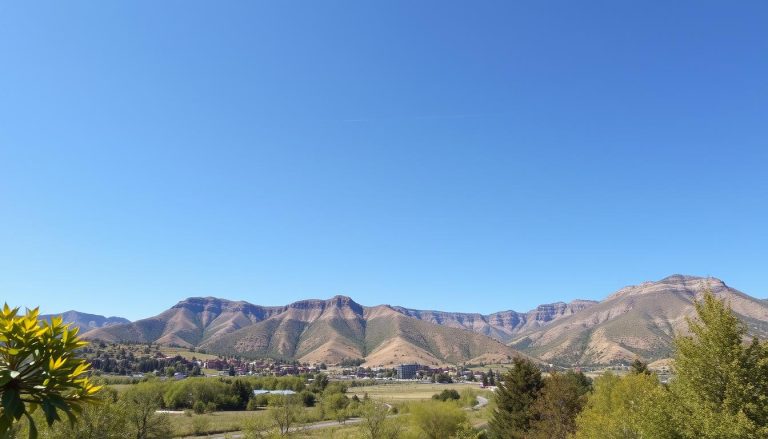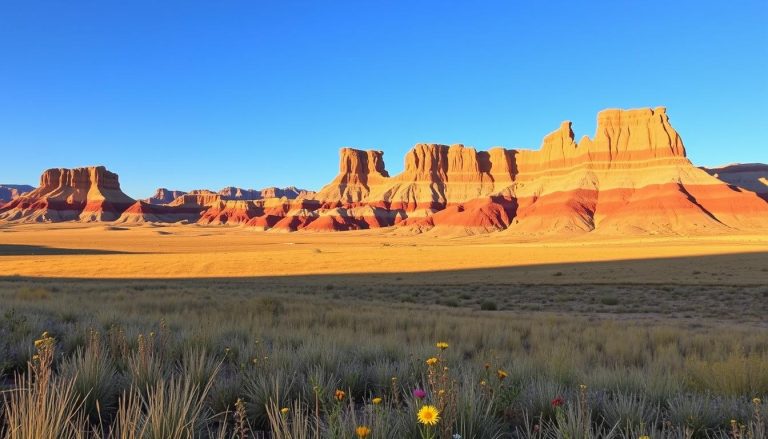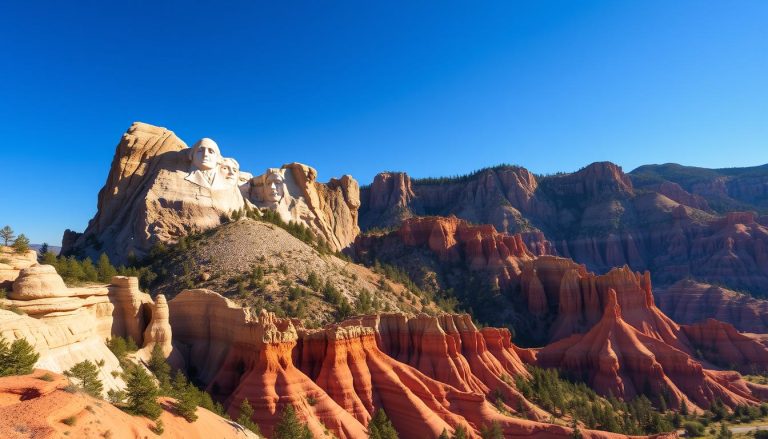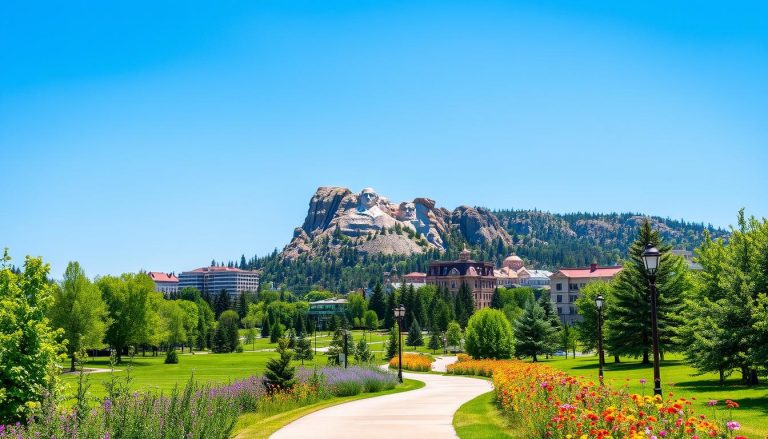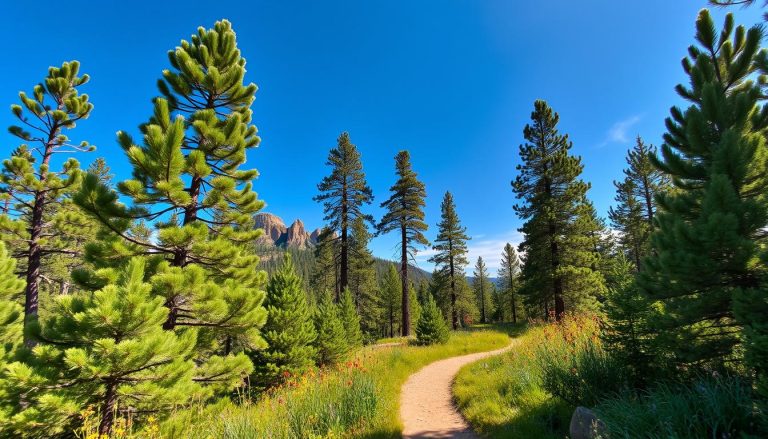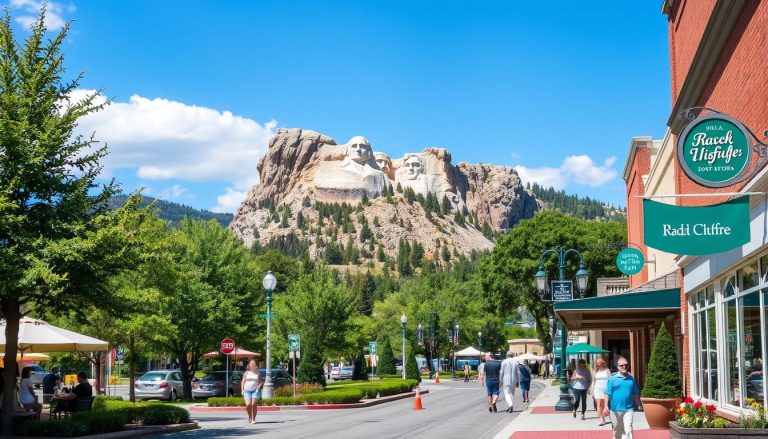Have you ever wondered why Wind Cave National Park is so unique and awe-inspiring? It’s in the heart of the Black Hills in South Dakota. This park has one of the largest cave systems in the world. But there’s more – above ground, you’ll find prairies, wildlife, and amazing hiking trails.
Exploring this park, you’ll find many natural wonders. From the detailed boxwork formations underground to the wildlife in the grasslands. Whether you want a thrilling cave adventure or a peaceful hike, Wind Cave National Park has something for everyone. Are you ready to see why this place is a top spot in South Dakota?
Key Takeaways
- Wind Cave National Park is home to one of the largest and most complex cave systems in the world, with over 95% of the world’s discovered boxwork formations.
- The park features a diverse landscape of prairies, wildlife, and hiking trails, offering something for every visitor.
- Visitors can choose from a variety of cave tours, ranging from the easy Garden of Eden tour to the strenuous Fairgrounds and Wild Cave tours.
- Hiking opportunities include the Rankin Ridge Trail and the Lookout Point Trail and Centennial Trail Loop, providing panoramic views of the park.
- Wind Cave National Park is the 7th largest cave system in the world and the 8th national park in the United States, established in 1903.
Discovering Wind Cave: History and Unique Features
Wind Cave National Park in South Dakota has a rich history. The cave got its name from the Lakota people, who called it Maka Oniye or “breathing earth.” It has been a place of wonder and reverence for centuries.
The Sacred Origins of Wind Cave
The Lakota people see Wind Cave as sacred. They believe it’s where their ancestors were born. The cave’s airflow and its connection to the underworld make it special to them.
Formation of the Unique Boxwork
Wind Cave is famous for its boxwork formations. These look like honeycombs and are made of thin calcite blades. They show the beauty of nature’s creation.
Historical Significance as the Seventh National Park
Wind Cave became the seventh national park on January 3, 1903. It was the first cave to be named a national park. This made it a key part of American history. Today, it has over 149 miles of passages, attracting visitors worldwide.
“Wind Cave is a maze of interconnected passages, the third-largest cave system in the United States and the sixth-largest in the world.”
Essential Guide to Cave Tours and Ticket Information
Exploring Wind Cave National Park’s underground world is a must. The cave tours are guided by rangers. They offer a chance to learn about the park’s history and see its amazing formations.
Booking your Wind Cave tour tickets early is a good idea. This is because tours often sell out, especially when many people visit. You can buy tickets online at recreation.gov up to 120 days in advance. Or, you can get same-day tickets at the visitor center, open from 8 am to 5 pm, but hours change with the seasons.
Wind Cave offers tours for everyone, no matter your age or fitness. The Natural Entrance Tour is a popular choice. It’s a moderate tour that shows off the park’s boxwork formations. For a more challenging adventure, try the Garden of Eden Tour. It goes deeper into the cave and includes tough passages.
| Tour Option | Difficulty | Duration | Ticket Price |
|---|---|---|---|
| Natural Entrance Tour | Moderate | 1 hour | $12 adult, $6 child |
| Garden of Eden Tour | Strenuous | 2 hours | $23 adult, $11 child |
| Fairgrounds Tour | Easy | 45 minutes | $7 adult, $3 child |
To get the most out of your visit, check the National Park Service website. It has the latest tour schedules and availability, which can change throughout the year.
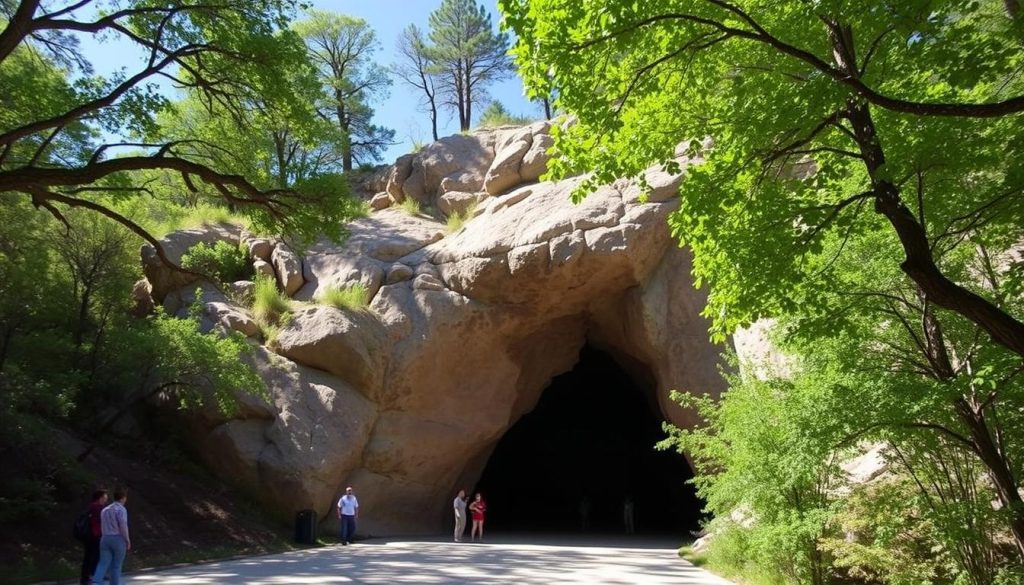
“Wind Cave is a remarkable natural wonder, and the tours provide an exceptional opportunity to explore its hidden depths and appreciate its unique geological features.”
Natural Entrance Tour: The Most Popular Experience
If you’re eager to explore Wind Cave National Park, the Natural Entrance Tour is a must. This 1.25-hour tour covers 0.66 miles and includes a 300-step descent. It offers a captivating glimpse into the park’s vast underground network.
What to Expect Underground
As you venture through the natural entrance, you’ll be awestruck by the extensive boxwork formations on the cave walls. These intricate, honeycomb-like structures are a rare and remarkable geological feature found almost exclusively in Wind Cave.
Tour Difficulty and Duration
The Natural Entrance Tour is rated as moderately difficult. It has paved but wet paths and some narrow passages. The descent and ascent can be challenging, but an elevator at the end of the tour returns you to the surface. Despite the physical demands, the tour’s duration of 1.25 hours provides ample time to absorb the cave’s mesmerizing sights.
Best Photo Opportunities
For avid cave exploration enthusiasts and photographers, the Natural Entrance Tour offers some of the best opportunities. It’s a chance to capture the stunning boxwork formations that have made Wind Cave a geological wonder. Be sure to bring your camera and prepare to be dazzled by the cave’s natural beauty.
“The Natural Entrance Tour is a must-do for anyone visiting Wind Cave National Park. It’s a captivating journey through one of the world’s largest and most unique cave systems.” – Park Ranger, Wind Cave National Park
Wildlife Viewing Opportunities in the Prairie
Wind Cave National Park is a top spot for wildlife lovers. It has one of the biggest mixed-grass prairies in the U.S. You can see many animals here, like bison, elk, prairie dogs, pronghorns, and coyotes.
The park’s wide roads, like SD-87 and US-385, are great for seeing bison. But, it’s important to stay far away. Even though they look calm, bison can be dangerous if you get too close.
- Spot the park’s famous bison herd grazing along the prairie
- Keep an eye out for elk, prairie dogs, pronghorns, and coyotes
- Explore the park’s roads, such as SD-87 and US-385, for the best wildlife viewing opportunities
- Maintain a safe distance of at least 100 feet when observing bison and other wildlife
The prairie ecosystem in Wind Cave National Park is amazing. It shows the variety of wildlife that lives here. Whether you love nature or just want to see something incredible, the park’s wildlife will amaze you.
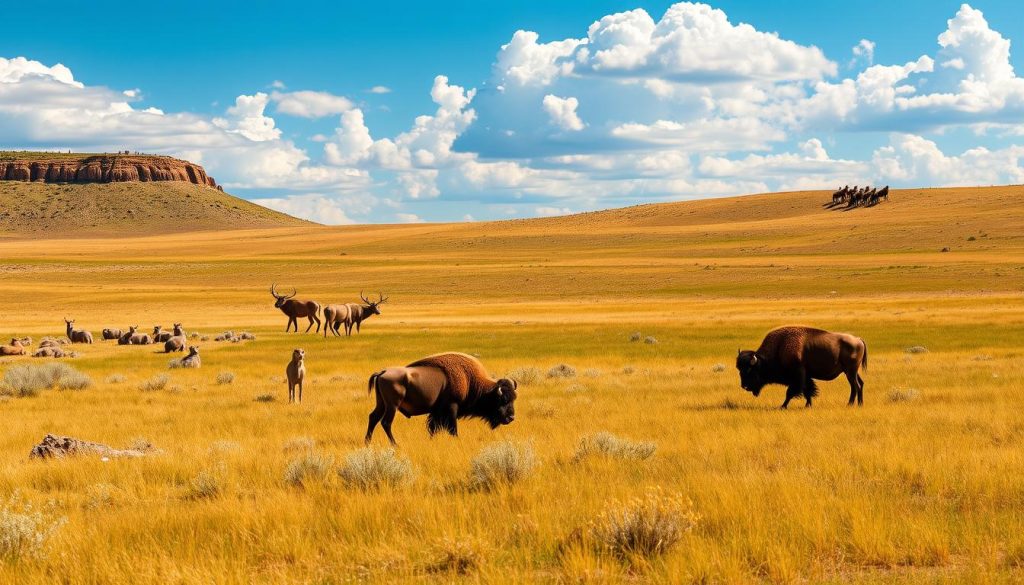
| Wildlife Commonly Seen | Approximate Population |
|---|---|
| Bison | 500-700 |
| Elk | 300-400 |
| Prairie Dogs | Thousands |
| Pronghorn | 200-300 |
| Coyotes | Numerous |
Wind Cave National Park’s prairie is full of wildlife. By walking the park’s roads and trails, you can see the bison and other animals. It’s a chance to see the beauty of this special place.
Rankin Ridge Trail: A Must-Do Hiking Experience
Looking for a hike with amazing views in Wind Cave National Park? The Rankin Ridge Trail is your answer. This 1-mile loop is a must-see, offering a moderate challenge and breathtaking 360-degree views.
Trail Details and Difficulty Level
The Rankin Ridge Trail is a 1.05-mile loop with an elevation gain of 253 feet. It’s a moderately challenging hike. It usually takes 30 to 60 minutes to finish, based on your speed and fitness.
The trail starts from SD-87 near the park’s northern entrance. There’s parking at the trailhead.
Panoramic Views and Photography Tips
The trail’s main attraction is its panoramic views. At its highest point, you’ll find the Rankin Fire Tower. Here, you can see 360 degrees of the landscape. On clear days, you might even see Badlands National Park.
For great photos, bring your camera. Visit during the golden hour for the best light.
Whether you love hiking or just want a memorable outdoor adventure, Rankin Ridge Trail in Wind Cave National Park is a must-see. So, get your hiking boots ready, pack your camera, and enjoy the stunning views this trail offers.
Lookout Point Trail and Centennial Trail Loop
Looking for a great prairie hike in Wind Cave National Park? The Lookout Point Trail and Centennial Trail Loop is perfect. This 4.8-mile loop is a mix of two famous trails. It’s an easy-to-moderate hike with 550 feet of elevation gain, taking 2 to 3 hours to finish.
This scenic path takes you through different landscapes. You’ll see lush prairie grass fields, shady ponderosa pine forests, and prairie dog towns. It’s a great chance to see wildlife like bison, elk, or pronghorn. Nature lovers will love this hike.
- Entrance Fee: Free
- Difficulty: Moderate
- Distance: 4.8 miles
- Time to Complete: 1 hour 54 minutes
- Elevation Gain: 492 feet
- Dog-friendly: No
Looking for views, wildlife, or a peaceful nature walk? The Lookout Point Trail and Centennial Trail Loop is a must-see. Get ready to be amazed by the park’s beautiful prairie and its diverse wildlife.
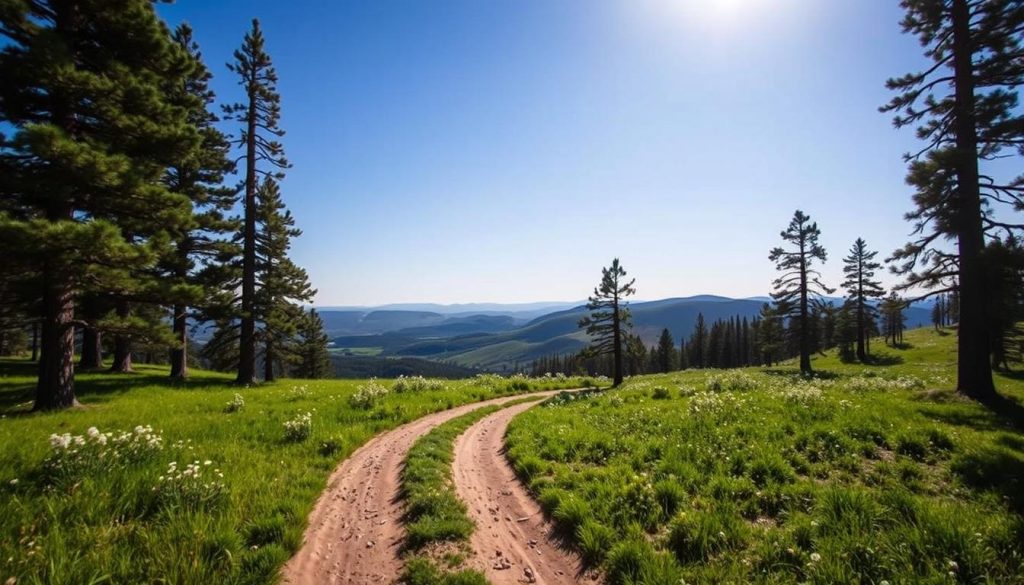
“The Lookout Point Trail and Centennial Trail Loop offers a truly immersive prairie hiking experience in Wind Cave National Park. It’s a fantastic way to connect with the land and its fascinating wildlife.”
Exploring the Backcountry Roads: NPS 5 and NPS 6
Wind Cave National Park lets visitors explore its backcountry roads, NPS 5 and NPS 6. These gravel roads are perfect for regular cars. They lead to the park’s eastern part, where bison and other wildlife live. A drive here is a great chance for nature lovers and adventure seekers.
Best Times for Wildlife Spotting
The best times to see wildlife on NPS 5 and NPS 6 are early morning and late afternoon. Bison, pronghorn antelope, and others are active and easy to spot. Visitors should watch carefully and stop safely to see the animals without scaring them.
Scenic Drive Routes and Highlights
- NPS 5: This route shows off the park’s wild landscapes. You might see bison herds and other wildlife. It also connects to Custer State Park, where you can compare the bison.
- NPS 6: This road takes you to the park’s eastern side. Here, you can see wide views of hills and grasslands. Look out for pronghorn antelope, deer, and other animals.
Exploring Wind Cave’s backcountry roads is a must for a real park experience. It’s perfect for wildlife fans or those who love beautiful views. These drives offer a unique and memorable adventure.
Seasonal Activities and Best Times to Visit
Wind Cave National Park in South Dakota is open all year. It offers many activities for visitors in every season. The cave stays a cool 53-54°F, perfect for escaping summer heat.
The cave tours are available every day, except major holidays. The best time to visit depends on what you like. Spring and fall have nice weather and fewer people. Fall is especially good for hearing elk bugle, a unique experience.
In summer, it can get hot with thunderstorms in the afternoon. But it’s great for hiking, seeing wildlife, and enjoying trails. Winter is special, with the cave warm and snow everywhere, perfect for snowshoeing or skiing.
Always check the weather and road conditions, especially in winter. Snow can make it hard to get there. Wind Cave National Park is a treasure to explore all year.
“Wind Cave National Park is one of the lesser visited National Parks in the country, offering a unique and intimate experience for those who venture to explore its underground marvels and vast prairie landscapes.”
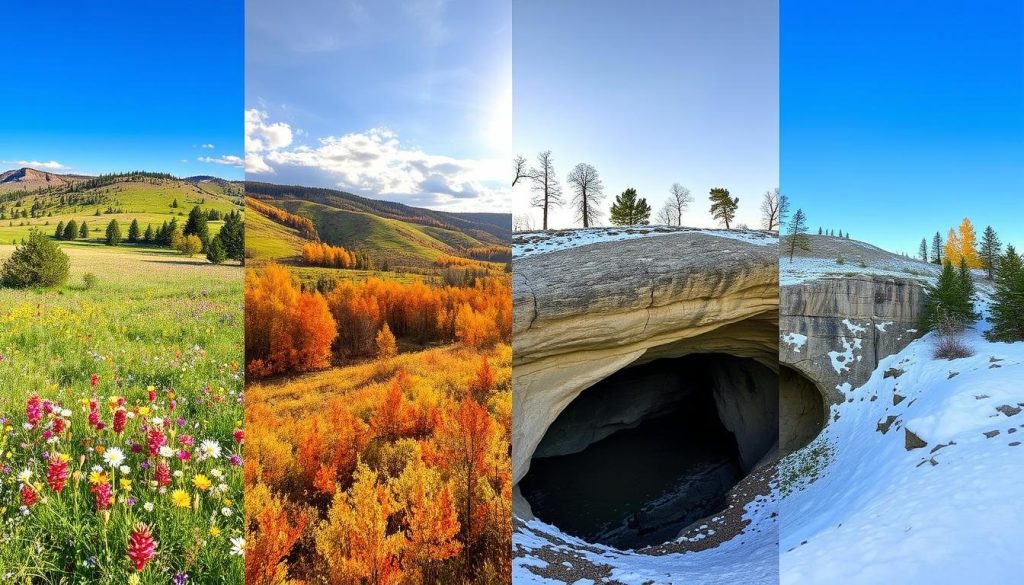
Wind Cave National Park is perfect for any season. Whether you want a quiet winter hike or a lively summer adventure, there’s something for everyone. Plan your visit to find the park’s hidden treasures and make memories that last a lifetime.
Camping and Accommodation Options
When you visit Wind Cave National Park, you’ll find many camping and lodging choices. The Elk Mountain Campground has 75 campsites for individuals and groups. It’s open all year, and you can book it on a first-come, first-served basis.
Summer campsites cost $18 and come with drinking water and toilets. Winter sites, from October to March, are $9 but don’t have water.
Looking for more comfort? The towns of Custer, Keystone, Hill City, and Hot Springs have many lodging options. Custer State Park, close to Wind Cave, has four lodges and nine campgrounds. It’s a great place to stay while exploring the Black Hills.
- The Bavarian Inn in Custer, SD, has 64 rooms. It offers pools, courts, a fitness trail, and a playground.
- The K Bar S Lodge in Keystone, SD, gives guests free breakfast and parking.
- The Baymont Inn and Suites Hot Springs in the Black Hills has hot breakfast, cozy beds, and more.
For food, try the Dakotah Steakhouse in Rapid City, SD. Meals are $8 to $20. The Delmonico Grill in Rapid City is famous for its fine dining and steaks.
“The Elk Mountain Campground at Wind Cave National Park offers 75 individual campsites along with group sites.”
Conclusion
Wind Cave National Park is a place of wonder, blending underground beauty with the prairie’s splendor. It has a vast cave system, diverse wildlife, and scenic trails. The park’s rich history adds to its allure, making it a memorable spot in South Dakota.
It’s close to famous sites like Mount Rushmore and Crazy Horse Memorial. This makes it a great stop on your South Dakota trip.
At Wind Cave, you can see unique cave formations, hike scenic trails, or watch bison in the wild. It’s perfect for anyone who loves nature and adventure. The park’s underground caves and wildlife are a must-see for Black Hills visitors.
When planning your trip to South Dakota, don’t miss Wind Cave National Park. Explore its underground wonders, see the stunning prairie, and make unforgettable memories. Your visit to Wind Cave will be a highlight of your journey through South Dakota’s natural and cultural wonders.

